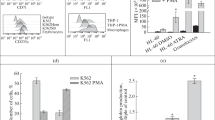Abstract
Recently, it has been suggested, that differentiated cells are more resistant to the apoptotic effect of DNA damaging agents possibly due to the decreased activity of “damage detecting/apoptosis triggering” mechanism. Previously, we have shown, that PMA pretreatment reduced etoposide-(ETO) but enhanced staurosporine- (STA) -induced apoptosis in HT58 cells. Data presented here show that the HT58 human, “mature” B-lymphoma cells exposed to PMA secrete more IgM into the supernatant indicating commitment of cells to perform differentiated function. The sensitivity of HT58 cells to ETO- or STA-induced apoptosis is influenced diversely with PMA pre- or posttreatment. Interestingly, the DNA damage (gamma radiation, bleomycin, ETO) or okadaic acic (30 nM) reduced the [PMA+STA] - induced apoptosis.
Similar content being viewed by others
Abbreviations
- BLEO:
-
bleomycin
- CDK:
-
cyclin dependent kinase
- CONT:
-
control
- ETO:
-
etoposide
- i-anti-IgM:
-
immobilized antihuman IgM antibody
- OKA:
-
okadaic acid
- PFC:
-
plaque forming cells
- PI:
-
propidium iodide
- PMA:
-
phorbol 12-myristate 13-acetate
- RAD:
-
gamma irradiation
- s-anti IgM:
-
solubilised anti-human IgM antibody
- STA:
-
staurosporine
References
Kaufmann SH: Induction of endonucleolitic DNA cleavage in human acute myelogenous leukemia cells by etoposide, camptothecin, and other cytotoxic anticancer drugs: a cautionary note. Cancer Res 49:5870–5878, 1989.
Hickman JA: Apoptosis induced by anticancer drugs. Cancer Metastat Rev 11:121–140, 1992.
Zhivotovsky B, Burgess DH, Vanags DM and Orrenius M: Involvement of cellular proteolytic machinery in apoptosis. Biochem Biophys Res Comm 230:481–488, 1997.
Darzynkiewicz Z: Apoptosis in antitumor strategies: modulation of cell cycle or differentiation. J Cell Biochem 58:151–159, 1995.
Warrel RP, Frankel SR, Miller WH et al: Differentiation therapy of acute promyelocytic leukemia with tretinoin (all-transretionic acid). New Eng J Med 324:1385–1393, 1991.
Studzinsky GP, Rathod B, Wang QM, et al: Uncoupling of cell cyle arrest from the expression of monocytic differentiation markers in HL60 cell variants. Exp Cell Res 232: 376–387, 1997.
Bathia U, Traganos F and Darzynkiewicz Z: Induction of cell differentiation potentiates apoptosis triggered by prior exposure to DNA-damaging drugs. Cell Growth Differ 6:937–944, 1995.
Linette GP and Korsmeyer SJ: Differentiation and cell death: lesson from the immune system. Curr Opin Cell Biol 6:809–815, 1994.
Liu LF: DNA topoisomerase poisons as antitumor drugs. Annu Rev Biochem 58:351–375, 1989.
Fry AM, Chresta CM, Davies SM et al: Relationship between topoisomerase II level and chemosensitivity in human tumor cell lines. Cancer Res 51:6592–6595, 1991.
Del Bino G., Skierski JS and Darzynkiewicz Z: The concentration-dependent diversity of the effect of DNA topoisomerase I and II on the cell cycle of HL-60 cells. Exp Cell Res 195:485–491, 1991.
Enoch T and Norbury C: Cellular responses to DNA damage: cell-cycle checkpoint, apoptosis and the roles of p53 and ATM. TIBS 20:426–430, 1995.
Kharbanda S, Pandey P, ** S et al: Functional interaction between DNA-PK and c-Abl in response to DNA damage. Nature 386:732–735, 1997.
Dubrez L, Savoy I, Hamman A and Solary E: Pivotal role of a DEVD-sensitive step in etoposide-induced and Fas-mediated apoptotic pathways. EMBO J 15:5504–5512, 1996.
Tamaoki T, Nomoto H, Takahashi I et al: Staurosporine, potent inhibitor of phospholipide/Ca++ dependent protein kinase. Biochem. Biophys. Res. Comm 135:397-402.
Gadbois DM, Hamaguchi JR, Swank RA and Bradbury EM: Staurosporine is a potent inhibitor of p34CDC2 and p34CDC2-like kinases. Biochem Biophys Res Comm 184:80–85, 1992.
Yoshida M, Usui T, Tsujimura K et al: Biochemical difference between staurosporine-induced apoptosis and premature mitosis. Exp Cell Res 232:225–239, 1997.
Mihalik R, Farkas Gy, Kopper L, et al: Possible involvement of protein kinase C-epsylon in phorbol ester-induced growth inhibition of human lymphoblastic cells. Int J Biochem Cell Biol 28: 925–933, 1996.
Shi L, Nishioka WK, Th’ng J et al: Premature p34cdc2 activation required for apoptosis. Science 263: 1143–1145, 1994.
Mihalik R, Kopper L and Benczur M: Modulation of drug-induced apoptosis in a human B-lymphoma cell line (HT58). Immunol Lett 48:17–21, 1995.
Gamard CJ, Blobe GC, Hannun YA and Obeid LM: Specific role for protein kinase C beta in cell differentiation. Cell Growth Differ 5:405–409, 1994.
Golding B, Pillemer SR, Roussou P et al: Inverse relationship between proliferation and differentiation in a human TNP-specific B cell line. J Immunol 131:2564–2568, 1988.
Kopper L, Bankfalvi A, Mihalik R. et al: New in vitro line from a human (B) non-Hodgkin lymphoma. Anticancer Res. 11:1645–1650, 1991.
Kiss K, Uher F and Gergely J: A natural IgM antiboby does inhibit polyclonal and antigen specific IgM but not IgG B cell responses. Immunol. Lett 39:235–241, 1994.
Gronowicz E, Coutinho A, Melchers F: A plaque assay for cells secreting Ig of a given type or class. Eur J Immunol 6:588–593, 1976.
Mihalik R, Uher H, Berczi L et al: Detection of drug-induced apoptosis by flow cytometry after alcaline extraction of ethanol fixed cells. Pathol Oncol Res 2:78–83, 1996.
Coleman TR and Dunphy WG: cdc2 regulatory factors. Curr Opin Cell Biol 6:877–882, 1994
Wolf CM, Reynolds JE, Morana SJ and Eastman A: The temporal relationship between protein phosphatase, ICE/CED-3 proteases, intracellular acidification and DNA fragmentation in apoptosis. Exp Cell Res 230:22–27, 1997.
Lock RB: Inhibition of p34cdc2 kinase activation, p34cdc2 tyrosine dephosphorylation, and mitotic progression in Chinese hamster ovary cells exposed to etoposide. Cancer Res. 52:1817–1822, 1992.
Lock RB, Thomson BS, Sullivan DM and Stribinskiene L: Potentiation of etoposide-induced apoptosis by staurosporine in human tumor cells is associated with events downstream of DNA-protein complex formation. Cancer Chemother Pharmacol 39:399–409, 1997.
Shimizu T, O’connor PM, Kohn KW and Pommier Y: Unscheduled activation of cyclin B1/cdc2 kinase in human promyelocytic leukemia cell line HL60 cells undergoing apoptosis induced by DNA damage. Cancer Res 55:228–231, 1995.
Author information
Authors and Affiliations
Corresponding author
Rights and permissions
About this article
Cite this article
Mihalik, R., Uher, F., PetÁk, I. et al. Regulation of differentiation, proliferation and drug-induced apoptosis in HT58 lymphoma cells. Pathol. Oncol. Res. 3, 100–105 (1997). https://doi.org/10.1007/BF02907802
Received:
Accepted:
Issue Date:
DOI: https://doi.org/10.1007/BF02907802




